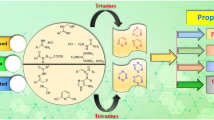Abstract
Ferrocene, the parent of the metallocene family of organotransition metal compounds, has come to occupy a significant niche in cancer research. Developmental work in the authors' laboratory has been focused on the synthesis of antiproliferative ferrocene conjugates in which the bioactive ferrocene unit is covalently, yet bioreversibly bound (anchored) to water-soluble carrier polymers designed in accordance with requisite biomedical specifications. The anchoring link in most of these conjugates has been an aliphatic spacer containing the biofissionable amide group. In this communication the synthesis of a class of ferrocene conjugates is reported in which the ferrocene group is carrier-anchored through spacers containing an ester link, of interest here because of potentially different drug release behavior. The carriers are polyamides equipped with variously spaced hydroxyl side groups, to which the ferrocenylation agent, 4-ferrocenylbutanoic acid, is connected through esterification. The coupling reactions, mediated by carbodiimide agent and catalyzed by 4-(dimethylamino)pyridine, are carried out in DMF at temperatures not exceeding 65°C, and the water-soluble product polymers are isolated in yields of typically 70–85% by precipitation, aqueous dialysis, and freeze-drying. With the molar feed ratios chosen in these coupling experiments, the incorporation of ferrocene, assessed by 1H NMR spectroscopy, corresponds to iron contents of roughly 2.5–5.5%, by mass. The conjugates will be included in a forthcoming bioactivity screening program.
Similar content being viewed by others
REFERENCES
P. Köpf-Maier, H. Köpf, and E. W. Neuse, J. Cancer Res. Clin. Oncol. 108, 336 (1984).
Briefly reviewed by E. W. Neuse and C. W. N. Mbonyana, in Inorganic and Metal-Containing Polymeric Materials, J. Sheats et al., ed. (Plenum Press, New York, 1990), p. 139.
M. G. Meirim, E. W. Neuse, and G. Caldwell, J. Inorg. Organomet. Polym. 8, 225 (1998), and preceding papers in this series.
G. Caldwell, M. G. Meirim, E. W. Neuse, and C. E. J. van Rensburg, Appl. Organometal. Chem. 12, 792 (1998).
P. Neri and G. Antoni, Macromol. Synth. 8, 25 (1982).
M. G. Meirim, E. W. Neuse, and G. Caldwell, J. Appl. Polym. Sci. 73, 2143 (1999).
J. C. Swarts, E. W. Neuse, and G. J. Lamprecht, J. Inorg. Organomet. Polym. 4, 143 (1994).
J. Flasák, F. Rypaček, J. Drobnik, and V. Saudek, J. Polym. Sci. Polym. Symp. 66, 59 (1979).
Author information
Authors and Affiliations
Rights and permissions
About this article
Cite this article
Neuse, E.W., Meirim, M.G., N”Da, D.D. et al. Polymer–Ferrocene Conjugates Containing an Ester Function in the Connecting Links. Journal of Inorganic and Organometallic Polymers 9, 221–230 (1999). https://doi.org/10.1023/A:1021706123621
Issue Date:
DOI: https://doi.org/10.1023/A:1021706123621




